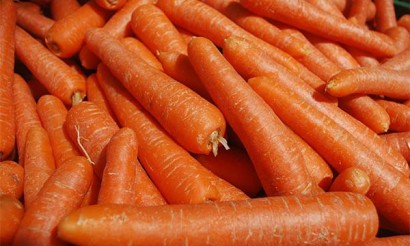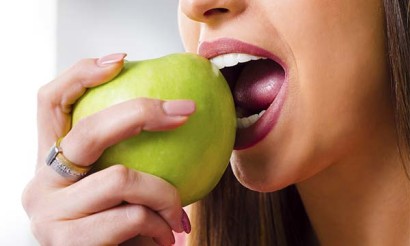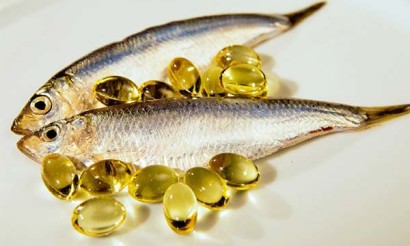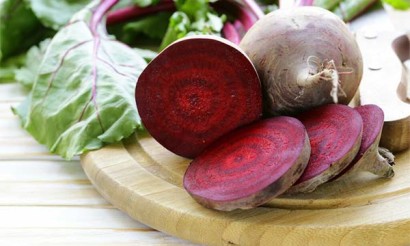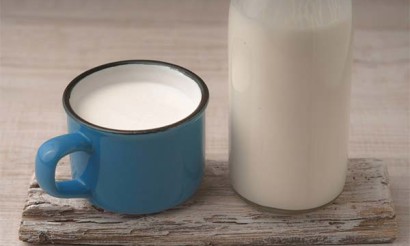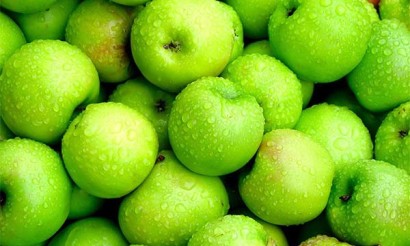Shrimp when breastfeeding: good or bad
Shrimp - a delicious, useful and nutritious product. They are rich in vitamins and minerals and are quite valuable for the body. Young mothers often ask the question about whether it is possible to eat shrimp while breastfeeding and how to properly introduce a new product into the diet.
- Is it possible to eat shrimp while breastfeeding
- In the first month
- In the second month
- How to eat shrimp correctly
- What do you combine it with?
- How much you can eat a day
- You can eat at night and on an empty stomach
- How to peel shrimp properly
- The benefits of shrimp when breastfeeding
- What are the dangers of shrimp in lactation
- How to correctly introduce shrimp into the diet of a nursing mother
- How to choose and store
- How to cook Shrimp: Recipes
- Boiled
- Fried
Can I eat shrimp while breastfeeding?
Shrimp are not forbidden products when breastfeeding. But the mother should eat them, observing certain rules. The thing is that this product is not only hard for the stomach, but also allergenic. Shrimp is often the cause of the baby unpleasant symptoms of allergies, as well as diathesis.

In addition, it is important to choose the right product, since artificially bred shrimp in its composition contain growth hormones and antibiotics. Mom can not eat such a product, because it can harm her and the baby.
In the first month
Despite the fact that shrimp is one of the foods that can be eaten during the breastfeeding period, it is strictly forbidden to eat it immediately after childbirth. This is due to the fact that the gastrointestinal tract of the child is not yet adapted to the new conditions and is not able to digest so heavy food.
It is in the first month of life the baby's mother should treat her diet responsibly and not introduce shrimp into their menu at this stage, even if she had eaten them during pregnancy.
Consumption of shrimp after birth, when the child is eating mother's milk, can lead to unpleasant consequences. Most often observed allergies and diathesis. The baby begins to worry rash, itching. Quite often children have diarrhea, flatulence and colic. Thus, in the first month of life of a child from the introduction of shrimp in the diet of a nursing mother should refuse.
In the second month
In the second month, mom can diversify her diet a little, because the baby's digestive system has matured and is ready to digest more complex compounds.
But even in the second month after childbirth, you should not eat shrimp. They contain complex compounds, harmful substances, growth hormones and antibiotics. In addition, the child's body is still prone to allergies to this product.
To protect your baby from the unpleasant consequences of an unhealthy diet, you should not eat shrimp.
Experts have not come to a single opinion on when the delicacy can be introduced into the mother's diet. Some argue that it should not be done earlier than six months after the birth of the child. Another group of doctors recommended to start trying the product as early as the 4th month.
It is up to mothers to decide when to introduce shrimp into the diet. But in any case, you should consult your pediatrician. The doctor will take into account all the peculiarities of the child's development and, based on the results of tests, will recommend the right time to introduce shrimp to the mother's diet. The product, when properly used, can bring invaluable benefits not only for the female body, weakened after childbirth, but also for the baby.
How to properly eat shrimp
It is important to eat the product correctly. Shrimp should be cleaned before eating. Eat them more often by hand, when they are a separate dish. But most often they are served already peeled. Only the tail is left, by which they take the shrimp and dip it in the sauce.
The crayfish cocktail is eaten with a special fork which is designed for oysters or desserts. A knife is not used, as the plate does not imply its use.
In the case when the shrimp is completely clean, there is no tail, they should be eaten with a knife and fork.
Consumption of raw shrimp during the breastfeeding period is strictly prohibited. If there is no heat treatment, their consumption will cause serious poisoning. Thus, the mother can harm not only herself, but also the baby, because everything she eats gets into the breast milk.
What to combine with
Shrimp can be a separate dish. They are boiled and eaten with sauce. They are also combined with almost all vegetables and even fruits. It is delicious and useful to eat shrimp with lemon zest, slices of orange or avocado. Vegetables, especially fresh cucumber, are also a good addition. Excellent combined with shrimp and tomato.
The ingredient is suitable for seafood salads, perfectly complements dishes with fish. They are dressed most often with olive oil. Sesame oil can also be used. It will give the dish an unusual flavor.
Shrimp are also used to make pasta. They are part of the Italian dish paella. The product is widely used to prepare not only appetizers and second courses, but also soups, pâtés and delicate soufflés. They go well with almost any seasoning, such as red pepper, coriander and herbs.
During the breastfeeding period such a wide application of the product will allow the nursing mother to choose dishes that are perfect for her and the baby. Proper use of shrimp during lactation will help to eliminate the occurrence of undesirable effects and bring benefits.
How much you can eat per day
A mother who breastfeeds her baby should pay special attention not only to the products she eats, but also to their quantity. Excessive consumption will lead to allergies, colic in the baby's tummy.
Experts recommend controlling the amount of shrimp. For the first time try no more than one medium-sized crustacean. If within three days the baby did not have unpleasant symptoms, the rate can be gradually increased.
A breastfeeding mother can eat no more than 3 medium-sized shrimp per day. It is recommended to eat them no more than 3 times a week. Thus, the weekly rate can not exceed 10 pieces.
Is it allowed to eat at night and on an empty stomach?
After the birth of a baby, many women begin to suffer from weight gain or digestive disorders. That is why the question arises about whether it is possible to eat shrimp at night.
These crustaceans belong to the protein foods. They are relatively easy for the digestive system and will not cause heaviness, bloating. In addition, shrimp do not have a high caloric value, are not harmful to the figure.
If the product is cooked correctly, without using a lot of vegetable oil, a few pieces eaten at dinner, will not harm the figure.
But experts recommend women to start eating shrimp at night when they are already introduced in the diet of a nursing mother. If a woman tries shrimp for the first time after childbirth, it is better to do it in the morning. This is necessary in order to observe the reaction of the baby to the new product during the day.
It is also worth remembering that eating in the evening is best for a couple of hours before going to bed. During this time the digestive system will digest the food and discomfort in the stomach will not arise.
It is not recommended to eat shrimp on an empty stomach. After sleeping it is better to give preference to the food, which adds energy and for a long time quenches the hunger. Shrimp is not one of these foods. It is best to eat them for lunch or dinner.
How to peel shrimp properly
The product before or after cooking must be cleaned of the shell. The cleaning process is quite simple:

- Take one shrimp by the head.
- Turn it upside down on its belly.
- Separate the legs from the body.
- Rip off the head.
- Remove the shell by gently pulling on it. It is easily removed from the entire surface of the shrimp.
So clean small and medium-sized shrimp. When cleaning large crustaceans you need to remove the intestines, which have the appearance of a thread of dark color. The process of cleaning them looks a little different:
- Separate the head from the body.
- Using a knife or scissors, cut the shell in the center for the entire length of the back.
- Open the shell and then remove it.
- Pull apart the halves of the back of the shrimp and remove the intestines. You can do this with a toothpick or special scissors.
The process of cleaning shrimp regardless of their size is not difficult, the main thing - a little practice.
The benefits of shrimp during breastfeeding
Shrimp is a useful product. It contains many substances necessary for the body, especially for women during the nursing period. Proper consumption of the product will only bring benefits to the body. Valuable properties are:
- Relieving fatigue. Shrimp contains amino acids that help eliminate accumulated fatigue. They also help the female body to recover faster after childbirth. Amino acids are involved in metabolism, strengthen hair and nails, activate the growth of muscle tissue.
- Improvement of the work of the brain. It is noted that regular consumption of shrimp allows you to activate the brain, improve cognitive abilities. This feature of the product lies in the presence in the composition of a substance called tryptophan.
- Maintenance of youthfulness. Shrimp contain a protein. It is involved in the construction of collagen fibers, the amount of which depends on the appearance of the skin. The consumption of shrimp allows preserving and prolonging youth.
- Improvement of the thyroid gland. Quite often after childbirth or during pregnancy women have endocrine system disruption, since the period of pregnancy proceeds with changes in the hormonal background. Shrimp contains iodine, which is necessary for the proper functioning of the thyroid gland.
- Strengthening of bones. It is known that seafood contains calcium in sufficient quantities. It is the basis of bone tissue. Thus, the consumption of shrimp helps to strengthen bones, teeth, as well as maintain the beauty of the hair.
- Regulation of sebaceous and sweat glands. The product contains sulfur. This trace element is necessary in the work of the sweat and sebaceous glands. When its insufficient amount is observed, the work of the glands is also disturbed, which entails the emergence of certain troubles and problems.
- Strengthening the hair and nail plate. This property of shrimp is due to the presence of zinc. The substance is necessary for the body in small quantities, but its deficiency also provokes deterioration of hair and nails.
- Maintenance of the cardiovascular system. Shrimp contains astaxanthin. It is he who gives the product such an unusual shade. The substance is also necessary for the work of the human heart muscle. In shrimp it is present in sufficient quantities.
- Protection of the circulatory system. This property is due to the presence of vitamin E. It has a positive effect on blood vessels, strengthens them and makes them more elastic.
- Improvement of the immune system. The seafood also contains vitamin C, which is the basis of a strong human immunity.
- Maintaining eyesight. Pregnancy and childbirth have a negative impact on the female body, which under the influence of various factors begins to change. Many mothers note the deterioration of vision. Regular consumption of shrimp and other seafood, as they contain vitamin A, will help maintain the visual apparatus.
- Ensure the proper development of the child's body. There is a substance called omega-3 in shrimp. It is responsible for the proper development of the baby, the formation of its organs. In addition, the amino acid has a positive effect on the condition of the skin and hair, strengthens dental enamel.
- Improvement of kidney function. During pregnancy, often there is a violation of the urinary system. Regular consumption of seafood, including shrimp, helps to improve it. They contain substances necessary for proper functioning of the kidneys.
- Reducing the risk of cancer. Scientists suggest that the consumption of shrimp helps to reduce the likelihood of cancer, as the product contains components that slow the formation of atypical cells.
- Removal of toxins and other harmful substances. Shrimp contain in its composition quite strong antioxidants. This is very important for the human body, especially for women during lactation. The fact that harmful substances penetrate into breast milk and cause unpleasant symptoms.
Shrimp is not a high-calorie food, which is useful when breastfeeding. In addition, the cholesterol present in the product is not harmful to the body, and does not deposit on the walls of blood vessels and does not cause blockages.
When properly consumed, shrimp can bring only good for the body of a nursing woman and her baby.
What are the dangers of shrimp during lactation?
It is important for a nursing mother to eat right. It should be remembered that shrimp are strong allergens, and eat them in the first 3-4 months after childbirth should not be. The baby may be allergic to the seafood, which is expressed in the appearance of red spots, itching, swollen mucous membranes of the throat and nose.
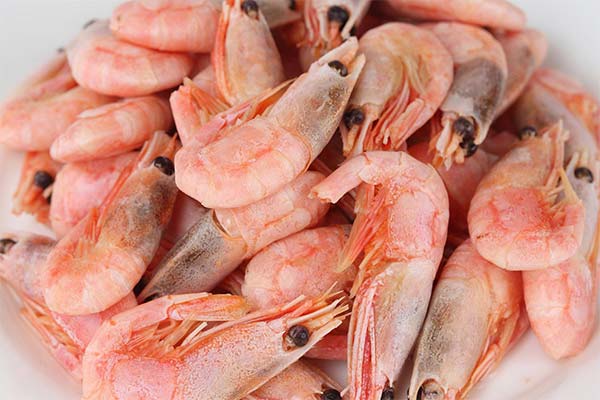
Store-bought shrimp are not grown in natural conditions. They often contain antibiotics and a variety of growth hormones. All these substances also pose a danger to the immature baby's body.
Mom should be aware of the fact that seafood, especially shrimp, and contain radioactive compounds, salts of heavy metals and other harmful substances. Throughout life, they accumulate them in their bodies. As a result, such a product is dangerous not only for the mother, but also for the baby, because all these substances penetrate into the breast milk.
Shrimp that has been re-frozen or improperly stored won't do any good either. It is best for a nursing mother to eat freshly caught shrimp. But this possibility is not always there. Therefore, it is important to choose and store the product correctly.
How to properly introduce shrimp in the diet of a nursing mother
The introduction of a new product in the diet is always carried out according to the same scheme. The first time shrimp should be tried when the baby will be at least three months. It is best to start trying crustaceans six months after delivery. Within three days, you need to watch the reaction of the child: if there were signs such as redness of the skin or mucous membranes, rash or itching, you need to refuse to use shrimp for another 2-3 months. But in the absence of unpleasant symptoms can safely eat the product. You should also take into account the following rules:
- For the first time it is enough to try only one medium shrimp. Such a portion will not harm the baby even if an allergic reaction occurs.
- Carefully monitor the baby's reaction to the introduction of a new product in the diet of a nursing mother.
- Experts recommend that if allergies occur, postpone the introduction of shrimp until after lactation. Only after that mom can eat the product without fear of harming the child.
- Norm of shrimp for a woman who breastfeeds her baby is only 3 pieces of medium size. You can eat up to 10 shrimp per week.
- The first time the product is tasted in the first half of the day. This makes it possible to observe the child throughout the day and, if necessary, take measures to ensure that the baby is not disturbed by colic and other unpleasant symptoms at night.
Compliance with simple rules contributes to the normal course of the period of introduction of shrimp in the diet of a nursing mother and reduces the risk of unpleasant consequences.
How to choose and store
A mother who breastfeeds her baby, it is important to eat only quality and fresh products. This also applies to shrimp. Today, really fresh crayfish can be purchased only by residents of cities located near water bodies where shrimp live. But more often in stores sold crustaceans, grown in artificial conditions.
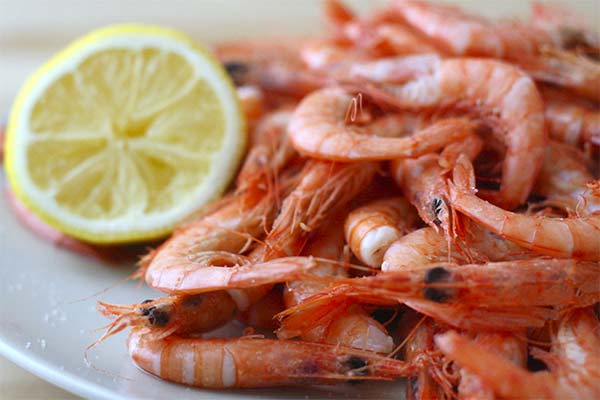
When choosing a woman is recommended to be guided by the following rules:
- Shrimp on weight should be crumbly. They do not stick to each other, each crayfish is separated. If they are sold in the factory packaging, it should not have lumps of ice and product. Their presence indicates that the shrimp was stored incorrectly, defrosted and frozen again. Such a product is not suitable for consumption.
- The shrimp has a bent tail. This indicates that the shrimp was caught alive and immediately subjected to freezing. If the shrimp has a straightened tail, it was caught dead. It is not allowed to eat such a product to a nursing mother, as it can cause poisoning.
- The color of the head should be from single to light brownish hue. Shrimp should not be black in color. It indicates that the crustaceans are toxic and will harm the body.
- You should also pay attention to the label. It should contain all the necessary information about the manufacturer, the type of shrimp, the date of packaging, expiration date and storage conditions.
- Packaged frozen shrimp can be stored up to one year at -18°C. The quality of the product decreases with the constant change in temperature, and as a result, it spoils and becomes unfit for consumption.
- Some manufacturers also indicate the amount of shrimp in the package, based on the rate per kilo. A figure of 50/70 and below indicates that the package contains shrimp of large size. Smaller ones are indicated as 70/90.
- Before buying, it is worth paying attention to storage conditions. If shrimp are purchased by weight, they should be stored in the store only in a tightly closed refrigerator. The original packaging must be airtight. Violation of its integrity indicates improper storage of the product. Shrimp can be spoiled.
- When choosing a package, take the one that is closest to the source of cold. It is best to take a package with the bottom.
Most often the packaging is transparent, so it is easy to determine the quality of the product. Shrimp should not have obvious signs of spoilage. This is a straight tail, the presence of black spots, dry shell. Do not be alarmed if the head of the crayfish has a green tint. It is not a sign of spoilage. Such color appears when the shrimp feeds on plankton.
Choosing a quality product is not difficult. It is important to choose carefully and buy shrimp only in trusted stores. It is important for a breastfeeding mother that everything she eats is of the highest quality. Not only her health depends on it, but also the health of the baby.
You should refuse to buy if the shrimp is covered with an ice crust or if there is a large amount of ice in the package. Do not eat the product, which has a soft meat, which has a yellowish color. This is an old shrimp, the use of which can lead to unfortunate consequences.
The health of the mother and baby depends on how properly cooked shrimp. Insufficient heat treatment will lead to poisoning, even after consuming the highest quality product.
How to cook shrimp: recipes
Shrimp do not need to cook for a long time, only 5-15 minutes is enough, depending on the size of the carcasses. Also, the following rules should be observed when cooking:
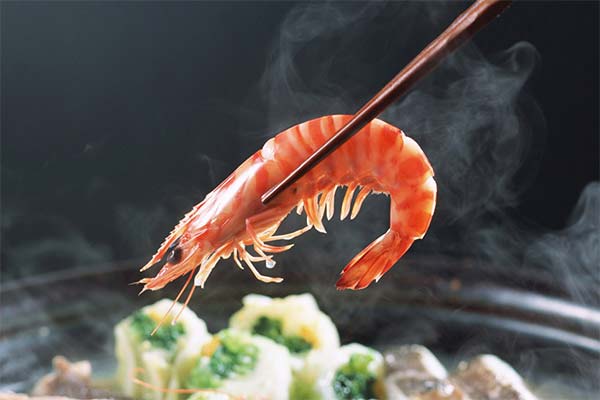
- Before boiling the crustaceans, dip them for 2 minutes in cold water. This is to ensure that the cooked meat is firm, not "rubbery".
- Before cooking large shrimp, cut the shell to remove the intestines.
- Take 2 liters of water per kilo of shrimp.
- Salt according to the amount of water: a spoon per liter.
- Before boiling, the shrimp do not need to be cleaned.
- Bring the water to a boil first, then drop the shrimp.
- Crustaceans are ready as soon as they begin to float on the surface.
- Drain the water through a colander.
Store cooked shrimp can not, they must be consumed immediately.
These simple rules will help to prepare the product deliciously.
Boiled
To get a delicious dish of shrimp, you can add a small amount of lemon juice or bay leaf to the water when boiling. This will give them a special flavor and aroma.
For a nursing mother, you can prepare a soup puree. To prepare it, you will need:
- 100 grams of cooked shrimp;
- 3 potatoes;
- 1 cheese melted;
- 1 carrot;
- 1 zucchini;
- 1 onion;
- 1 tablespoon of butter;
- salt and spices to taste.
Boil the vegetables until fully cooked, add the butter and cheese. Using a blender, blend everything until smooth. Shrimp fry in a little butter and put as a decoration to the resulting puree. You can also add spices in a small amount.
Fried
This dish will help to diversify the diet of a nursing mother. To prepare you will need shrimp, a small amount of vegetable or olive oil, 20 grams of butter and spices.
Defrost the shrimp first. To do this, you should transfer them from the freezer to the refrigerator in advance. Then peel the shrimp.
Shrimp put on a heated and oiled pan. Fry them, stirring all the time, for 6-8 minutes. Two minutes before they are ready, season and add butter. After that, turn off the stove and cover the pan for a couple of minutes.
Cooking shrimp is not difficult. It does not require special skills and knowledge.
Shrimp is a valuable product for the body. They can be eaten by the mother during the breastfeeding period, but care should be taken and before introducing them into the diet, be sure to consult a doctor. This will greatly reduce the risk of adverse effects.
«Important: All information on this site is provided solely for introductory for your own health. Before applying any recommendations, you should consult with a specialized specialist. Neither the editors nor the authors shall be liable for any possible harm caused by materials."



